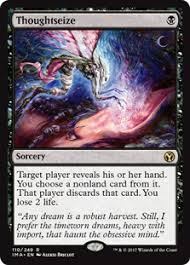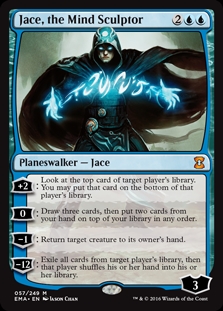Different Card types

lands
Lands are what what generate mana. Mana is used to cast all the spells used in Magic the Gathering. There are
five basic lands which represent the five colors of magic. Forest(green) represent big creatures in Magic.
Green also has spells that get more lands. Plains(white) consist of creatures that gain life and have the attribute
of flying. Mountain(red) consists of spells that do damage and creatures that are aggressive. Swamps(black)
represent destruction and creatures that destroy. Islands(blue) consist of counter spells and spells that draw cards.
There are other lands that are not considered basic lands. They all create mana in different ways.

Creatures
Creatures are played on the player's own main phase, when the stack is empty. When a creature comes into play or changes controllers,
it has what is commonly called "summoning sickness" until the beginning of its controllers next turn. A creature with summoning sickness
cannot attack or use an activated ability with the tap symbol in its cost, but it can block or use any other abilities it has. A tapped creature
cannot attack, block, or become tapped as a cost. Creatures represent warriors, minions, beasts and monsters that serve
the player, usually by fighting on his or her behalf. Because almost all creatures can attack each turn to reduce an opponent's life, or block
the opponent's attackers, creature cards are fundamental to most deck strategies.On the bottom-right corner of each creature card is that creature's
power and toughness, respectively. The power is the amount of damage a creature deals to an opponent or other creatures in combat, and the
toughness is the amount of damage a creature can survive. A creature with damage equal to or greater than its toughness has "lethal damage,"
and is destroyed. Similarly, a creature whose toughness is reduced to zero or less will go to its owner's graveyard (though it is technically not destroyed.)
Any damage a creature takes will accumulate until the end of the turn, when all damage is removed from all creatures. Unlike other card types,
almost all creature cards have a subtype, also referred to as a "creature type." There are no rules inherent to creature types, but there are many cards
that affect specific types. In addition, creature types are often associated with particular colors and abilities, typically for flavor purposes. For example,
angels are almost always large white flying creatures, spiders are typically green creatures with high toughness and an ability to block flyers, and goblins
are often small red creatures with self-destructive abilities.

Instant Spells
Theese spells can be cast at any phase. These spells are only a one time affect.
They are not put on the battlefield. As soon as they resolve, they are put into the player's graveyard.
These spells are often used in response to another player playing something.

Sorcery Spells
The spells are much like instant spells. The only difference is that you can only cast these during your
main phases. Sorceries seem to be weaker than instants because they cannot be cast at any time.

Planeswalker Spells
Planeswalker card types were introduced in Lorwyn. Like the player, a planeswalker card represents a
powerful being that is able to move from plane to plane.Planeswalkers enter the battlefield with a set number
of loyalty counters, printed in the lower right of the card. A planeswalker can be attacked, like a player,
or be dealt damage by an opponent redirecting the damage one of his or her spells would deal to the
player controlling the planeswalker. Damage dealt to a planeswalker removes that many loyalty counters and
a Planeswalker with no loyalty counters is put into the graveyard. Planeswalkers usually have three abilities: one
ability that adds loyalty counters as a cost for a small benefit, one that removes a small amount of counters
as a cost for a larger effect, and one that removes a large number of loyalty counters for a big effect. The last
effect is commonly referred to as the Planeswalker's Ultimate ability and usually leaves the opponent in a devastated state.
The starting loyalty of a Planeswalker is commonly significantly lower than the cost of the Ultimate and a player has to
build up the loyalty to access the Ultimate.